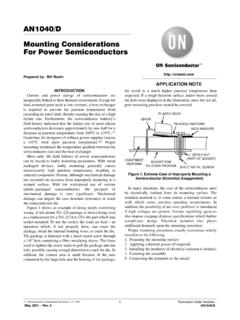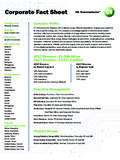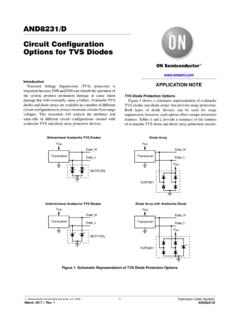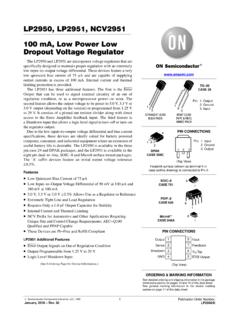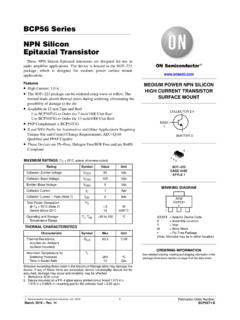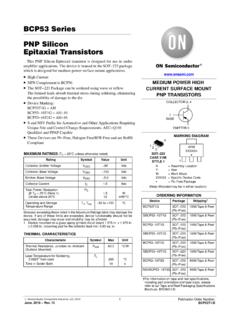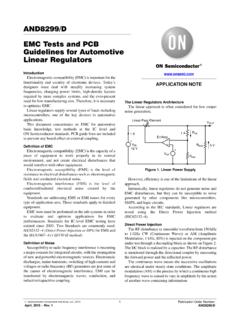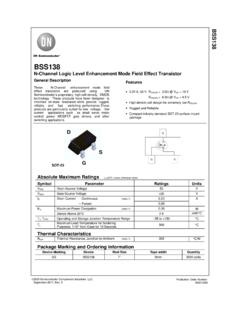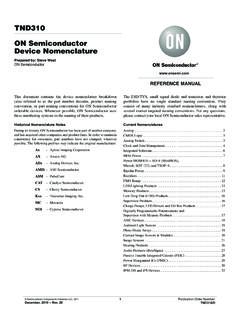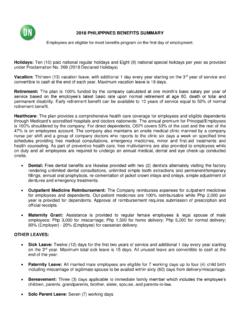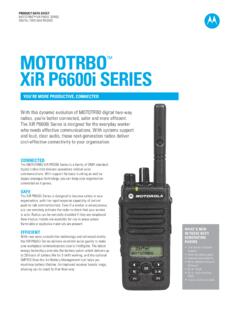Transcription of Switch
1 Switch Mode power SupplyReference ManualSMPSRM/DRev. 4, Apr 2014 SCILLC, 2014 Previous Edition 2002 All Rights Reserved 2ON Semiconductor and are registered trademarks of Semiconductor Components Industries, LLC (SCILLC). SCILLC owns the rights to a number of patents, trademarks,copyrights, trade secrets, and other intellectual property. A listing of SCILLC s product/patent coverage may be accessed at SCILLC reserves the right to make changes without further notice to any products herein. SCILLC makes no warranty, representation or guarantee regarding the suitability of its products for anyparticular purpose, nor does SCILLC assume any liability arising out of the application or use of any product or circuit, and specifically disclaims any and all liability, including withoutlimitation special, consequential or incidental damages. Typical parameters which may be provided in SCILLC data sheets and/or specifications can and do vary in different applicationsand actual performance may vary over time.
2 All operating parameters, including Typicals must be validated for each customer application by customer s technical experts. SCILLC does not convey any license under its patent rights nor the rights of others. SCILLC products are not designed, intended, or authorized for use as components in systems intended forsurgical implant into the body, or other applications intended to support or sustain life, or for any other application in which the failure of the SCILLC product could create a situation wherepersonal injury or death may occur. Should Buyer purchase or use SCILLC products for any such unintended or unauthorized application, Buyer shall indemnify and hold SCILLC andits officers, employees, subsidiaries, affiliates, and distributors harmless against all claims, costs, damages, and expenses, and reasonable attorney fees arising out of, directly or indirectly,any claim of personal injury or death associated with such unintended or unauthorized use, even if such claim alleges that SCILLC was negligent regarding the design or manufactureof the part.
3 SCILLC is an Equal Opportunity/Affirmative Action Employer. This literature is subject to all applicable copyright laws and is not for resale in any ORDERING INFORMATIONN. American Technical Support: 800 282 9855 Toll FreeUSA/CanadaEurope, Middle East and Africa Technical Support:Phone: 421 33 790 2910 Japan Customer Focus CenterPhone: 81 3 5817 1050 LITERATURE FULFILLMENT:Literature Distribution Center for ON Box 5163, Denver, Colorado 80217 USAP hone: 303 675 2175 or 800 344 3860 Toll Free USA/CanadaFax: 303 675 2176 or 800 344 3867 Toll Free USA/CanadaEmail: Semiconductor Website: Literature: additional information, please contact your localSales 3 ForwardEvery new electronic product, except those that are battery powered, requires converting off line115 Vac or 230 Vac power to some dc voltage for powering the electronics. The availability of designand application information and highly integrated semiconductor control ICs for switching powersupplies allows the designer to complete this portion of the system design quickly and you are an experienced power supply designer, designing your first switching powersupply or responsible for a make or buy decision for power supplies, the variety of informationin the Switch Mode power Supply Reference Manual should prove reference manual contains useful background information on switching power supplies forthose who want to have more meaningful discussions and are not necessarily experts on powersupplies.
4 It also provides real SMPS examples, and identifies several application notes andadditional design resources available from ON Semiconductor, as well as helpful books availablefrom various publishers and useful web sites for those who are experts and want to increase theirexpertise. An extensive list and brief description of analog ICs, power transistors, rectifiers and otherdiscrete components available from ON Semiconductor for designing a SMPS are also the latest updates and additional information on energy efficient power management and discretedevices, please visit our website at Skip is a trademark of Semiconductor Components Industries, LLC. ENERGY STAR is a registered mark mark. All brandnames and product names appearing in this document are registered trademarks or trademarks of their respective 4 Table of ContentsPageIntroduction versus Switching power Supplies power Supply Fundamentals Forward Mode Converter Flyback Mode Converter Switching power Supply Topologies Multiphase Converters the Method of Control Choice of Semiconductors Switches Bipolar power Transistor power MOSFET MOSFETs in Switching power Supply Applications Insulated Gate Bipolar Transistor (IGBT)
5 Magnetic Components Out the Printed Circuit Board and Stresses in Switching power Supplies to Improve Efficiency in Switching power Supplies Synchronous Rectifier and Clamps Lossless Snubber Active Clamp Resonant Topologies Factor Correction Overview Examples Documentation Available from ON Semiconductor Notes Notes 5 IntroductionThe never ending drive towards smaller and lighterproducts poses severe challenges for the power supplydesigner. In particular, disposing of excess heatgenerated by power semiconductors is becoming moreand more difficult. Consequently it is important that thepower supply be as small and as efficient as possible, andover the years power supply engineers have responded tothese challenges by steadily reducing the size andimproving the efficiency of their power supplies offer not only higherefficiencies but also greater flexibility to the advances in semiconductor, magnetic and passivetechnologies make the switching power supply an evermore popular choice in the power conversion guide is designed to give the prospective designeran overview of the issues involved in designingswitchmode power supplies.
6 It describes the basicoperation of the more popular topologies of switchingpower supplies, their relevant parameters, providescircuit design tips, and information on how to select themost appropriate semiconductor and passivecomponents. The guide also lists the ON Semiconductorcomponents expressly built for use in switching versus SwitchingPower SuppliesSwitching and linear regulators use fundamentallydifferent techniques to produce a regulated outputvoltage from an unregulated input. Each technique hasadvantages and disadvantages, so the application willdetermine the most suitable power supplies can only step down an inputvoltage to produce a lower output voltage. This is doneby operating a bipolar transistor or MOSFET pass unit inits linear operating mode; that is, the drive to the pass unitis proportionally changed to maintain the required outputvoltage.
7 Operating in this mode means that there isalways a headroom voltage, Vdrop, between the inputand the output. Consequently the regulator dissipates aconsiderable amount of power , given by (Vdrop Iload).This headroom loss causes the linear regulator to onlybe 35 to 65 percent efficient. For example, if a Vregulator has a 12 V input and is supplying 100 mA, itmust dissipate 700 mW in the regulator in order to deliver500 mW to the load , an efficiency of only 42 cost of the heatsink actually makes the linearregulator uneconomical above 10 watts for smallapplications. Below that point, however, linearregulators are cost effective in step down low drop out (LDO) regulator uses an improvedoutput stage that can reduce Vdrop to considerably lessthan V. This increases the efficiency and allows thelinear regulator to be used in higher power with a linear regulator is simple and cheap,requiring few external components.
8 A linear design isconsiderably quieter than a switcher since there is nohigh frequency switching power supplies operate by rapidly switchingthe pass units between two efficient operating states: cutoff, where there is a high voltage across the pass unitbut no current flow; and saturation, where there is a highcurrent through the pass unit but at a very small voltagedrop. Essentially, the semiconductor power switchcreates an AC voltage from the input DC voltage. ThisAC voltage can then be stepped up or down bytransformers and then finally filtered back to DC at itsoutput. Switching power supplies are much moreefficient, ranging from 65 to 95 downside of a switching design is that it isconsiderably more complex. In addition, the outputvoltage contains switching noise, which must beremoved for many there are clear differences between linearand switching regulators, many applications require bothtypes to be used.
9 For example, a switching regulator mayprovide the initial regulation, then a linear regulator mayprovide post regulation for a noise sensitive part of thedesign, such as a sensor interface power SupplyFundamentalsThere are two basic types of pulse width modulated(PWM) switching power supplies, forward mode andboost mode. They differ in the way the magneticelements are operated. Each basic type has its advantagesand Forward Mode ConverterThe forward mode converter can be recognized by thepresence of an L C filter on its output. The L C filtercreates a DC output voltage, which is essentially thevolt time average of the L C filter s input ACrectangular waveform. This can be expressed as:Vout[Vin@duty cycle (eq. 1)The switching power supply controller varies the dutycycle of the input rectangular voltage waveform and thuscontrols the signal s volt time buck or step down converter is the simplestforward mode converter, which is shown in Figure 6 IpkTIMEI loadIminPowerSwitch OFFP owerSwitch OFFP owerSwitch ONPowerSwitch ONVsatPower SWPower SWDiodeDiodeTIMEF igure 1.]
10 A Basic Forward Mode Converter and Waveforms (Buck Converter Shown)VfwdINDUCTOR CURRENT(AMPS)DIODE VOLTAGE(VOLTS)LORloadCoutDVinSWIonIoffIt s operation can be better understood when it is brokeninto two time periods: when the power Switch is turnedon and turned off. When the power Switch is turned on,the input voltage is directly connected to the input of theL C filter. Assuming that the converter is in asteady state, there is the output voltage on the filter soutput. The inductor current begins a linear ramp from aninitial current dictated by the remaining flux in theinductor. The inductor current is given by:iL(on)+(Vin*Vout)Lt)iinit0vtvton(eq. 2)During this period, energy is stored as magnetic fluxwithin the core of the inductor. When the power switchis turned off, the core contains enough energy to supplythe load during the following off period plus somereserve the power Switch turns off, the voltage on theinput side of the inductor tries to fly below ground, but isclamped when the catch diode D becomes forwardbiased.
